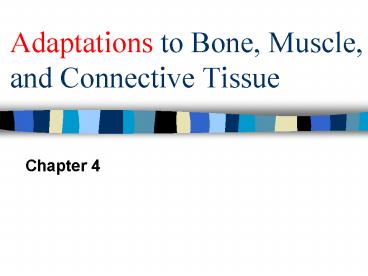Adaptations to Bone, Muscle, and Connective Tissue - PowerPoint PPT Presentation
1 / 34
Title:
Adaptations to Bone, Muscle, and Connective Tissue
Description:
Discuss the response of the tissues above to training ... structural exercises: squats, cleans, deadlifts, bench presses, shoulder presses ... – PowerPoint PPT presentation
Number of Views:149
Avg rating:3.0/5.0
Title: Adaptations to Bone, Muscle, and Connective Tissue
1
Adaptations to Bone, Muscle, and Connective Tissue
- Chapter 4
2
Objectives
- Describe the anatomy of bone, muscle, tendon and
ligaments - Discuss the response of the tissues above to
training - Design a program to stimulate growth of the above
tissues
3
Bone Modeling
- Wolffs Law- bone responds by adapting to applied
stress - Osteoblasts (formation of bone)
- Osteoclasts (removal of bone)
- Collagen matrix
- Periosteum (outer covering)
- Trabecular bone (spongy)
- Cortical bone (solid)
4
(No Transcript)
5
(No Transcript)
6
(No Transcript)
7
(No Transcript)
8
Skeleton
- Axial skeleton- skull, spinal column
- Appendicular skeleton- upper extremity, shoulder
girdle, lower extremity, pelvic girdle
9
Bone Hypertrophy
- Minimal essential strain- the threshold stimulus
for the formation of new bone - Activities must be weight-bearing to stimulate
increases in bone density
10
Bone Atrophy
- Bone atrophy occurs with
- Bed rest
- Prolonged inactivity
- Space travel
- Osteoporosis
- Menopause related
- Age related
- Female athletic triad (disordered eating,
amenorrhea and osteoporosis. A female athlete can
have one, two, or all three parts of the triad.
11
Designing training programs to elicit osteogenic
stimuli
- Specificity of loading- perform exercises that
stress the part of the skeleton where increases
in bone density are desired - Axial loading
- Exercise selection- force vectors through the
spine and hip, multiple muscles, multi-joint, use
greater absolute loads
12
Designing training programs to elicit osteogenic
stimuli
- Progressive overload- gradually increase the
training loads - Training variation- vary the selection of
exercises to vary the distribution of forces
13
Mechanical Loading of the Musculoskeletal System
- Magnitude of the load (intensity)
- Rate (speed) of loading
- Direction of the forces
- Volume of loading (sets x repetitions)
14
Activity and Bone Density
- Resistance exercise- few studies have looked at
bone mineral density with resistance training,
results are variable, no studies focus on the
rate and magnitude of loading - Aerobic exercise- high intensity repetitive
activities such as rowing, stair climbing, and
running have been moderately successful in
demonstrating bone mineral density increases
15
Resistance Exercise Rx for Stimulating Bone
Density
- Volume 3-6 sets, up to 10 repetitions
- Load- 1RM to 10RM range
- Rest- 1-4 minutes
- Variation- periodized
- Exercise selection- structural exercises squats,
cleans, deadlifts, bench presses, shoulder presses
16
Muscular Adaptation
- Specific to fiber type recruited
- Hypertrophy
- Hyperplasia
17
Training for Muscle Strength
- High resistance, near maximal muscle actions, few
number of repetitions, complete recovery between
sets, stimulate FT muscle fibers
18
Connective Tissue Adaptation
- Type I collagen is a protein that is the major
collagen fiber in bone, tendons, and ligaments - Fibroblasts, cells that synthesize new materials,
synthesize procollagen - Procollagen consists of three strands of protein
in a triple helix
19
- Microfibril- parallel arrangement of collagen
filaments - Collagen cross links (covalent cross linking)
to increase tensile strength - Collagen is in the extracellular space- outside
the cell membrane
20
(No Transcript)
21
(No Transcript)
22
Ligaments, Tendons, and Fascia
- Ligaments- connect bone to bone
- Tendons- connect muscle to bone
- Fascia- fibrous covering of skeletal muscle
- Endomycium, perimysium, epimysium
23
(No Transcript)
24
(No Transcript)
25
Cartilage
- Provide a smooth articulating surface between two
bones in a joint - Act as a shock absorber
- Aid in attaching muscles to bone
- Limits translation
26
Cartilage
- Chondrocytes- cells that produce cartilage
- Hyaline cartilage (articular cartilage) covers
the ends of long bones - Ground substance- gel-like carbohydrate material
in the type II collagen of cartilage - Fibrous cartilage- tough fibrous bundles of type
I and type I collagen, intervertebral disks,
menisci
27
(No Transcript)
28
(No Transcript)
29
(No Transcript)
30
Tendons and Ligaments
- In aerobic exercise, collagen metabolism
increases to repair collagen damaged during
exercise - In high intensity exercise, there is a net growth
of connective tissue (ligaments and tendons)
causing an increase in cross-sectional area and
strength - Ligament/bone attachment is the weakest link in
that system
31
Changes in Tendon
- Increase in collagen fibril diameter
- A greater number of covalent cross-links within a
fibril of increased diameter - An increase in the number of collagen fibrils
- An increase in the packing density of collagen
fibrils - Enhanced ability to withstand greater tensile
forces
32
Effects of Physical Activity on Cartilage
- Cartilage gets its nutrient supply from synovial
fluid - Joint movement (exercise) increases the nutrient
supply to cartilage - Immobilization of a joint causes death of
chondrocytes and resorption of cartilage matrix
33
- Moderate aerobic exercise increases cartilage
thickness - Severe aerobic exercise or anaerobic exercise
does not appear to cause degenerative joint
disease
34
Next Class
- Chapter 21 Aerobic































